It might surprise you to learn that cats lived among the ancient people of Mesopotamia for at least 100,000 years. It is known that all cats originated in Asia. The Felidae family descended from the African wildcat. Since ancient times, cat legends have preserved these early beginnings.
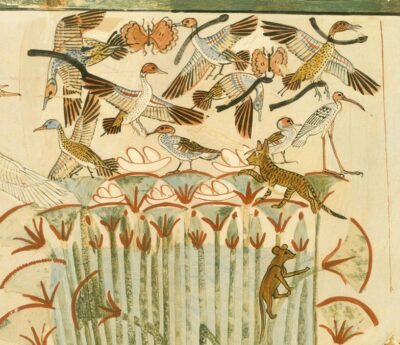
The African Wildcat has a prehistory that indicates that the cat developed over 12 million years ago. Cats, independent creatures who had to find their own means of survival, deemed it helpful to live among Mesopotamian people, becoming domesticated there in approximately 12,000 BCE (Before Common Era), about the same time as dogs, sheep, and goats.
Bred by Mesopotamian farmers for pest control, the Near Eastern wildcat proves to be the closest relative to today’s domestic cat. One marker of domestication shows the changes in an animal’s physical looks, yet modern domestic cats retain basically the same shape as those of their earlier ancestors.
Not only that, but they still retain the same behavior as these early felines and have the same basic food habits. Some sources suggest that our modern house cat has still not become fully domesticated.
RESEARCH PROJECT HEADED BY DR. ANDREW KITCHENER
Interesting research has been done to show that the origin of the domestic cat was not ancient Egypt, but Mesopotamia, and that this domestication occurred much earlier than we thought. This evidence points to the fact that the last common ancestor of wildcats and domestic cats lived more than 100,000 years ago.
Dr. Andrew Kitchener, zoologist at the National Museum of Scotland, headed a research project using DNA samples from 979 wild and domestic cats. Dr. Kitchener and his team looked for markers in mitochondrial DNA, a type of genetic material passed down from mothers to kittens.
This material can reveal when wild and domestic cat lineage showed the closest relationship. Dr. Kitchener’s study showed that the origin of domestic cats was not ancient Egypt, as has long been surmised, but Mesopotamia.
This evidence had its basis upon evidence provided by the discovery in 983 CE of a cat skeleton in a grave that dated back to 9,500 BCE, on the island of Cyprus. Ancient man discovered early on that the cat could be extremely useful in protecting necessary food supplies from vermin.
The cat, drawn to a fine source of food, did not object to becoming useful for this purpose.
This video gives a view of ancient history according to cats.
CATS IN ANCIENT EGYPT
If you search this website, you will find that many stories exist about cats in ancient Egypt. For example, by 450 BCE, the penalty in Egypt for killing a cat was death. In fact, it is believed that this penalty had originated at a much earlier time.
Egyptians cared so much for their cats that they placed the safety of these enigmatic animals above human life and property. At that time, if an Egyptian house caught fire, the inhabitants became most concerned about rescuing their cats, often running back into the building to rescue the feline.
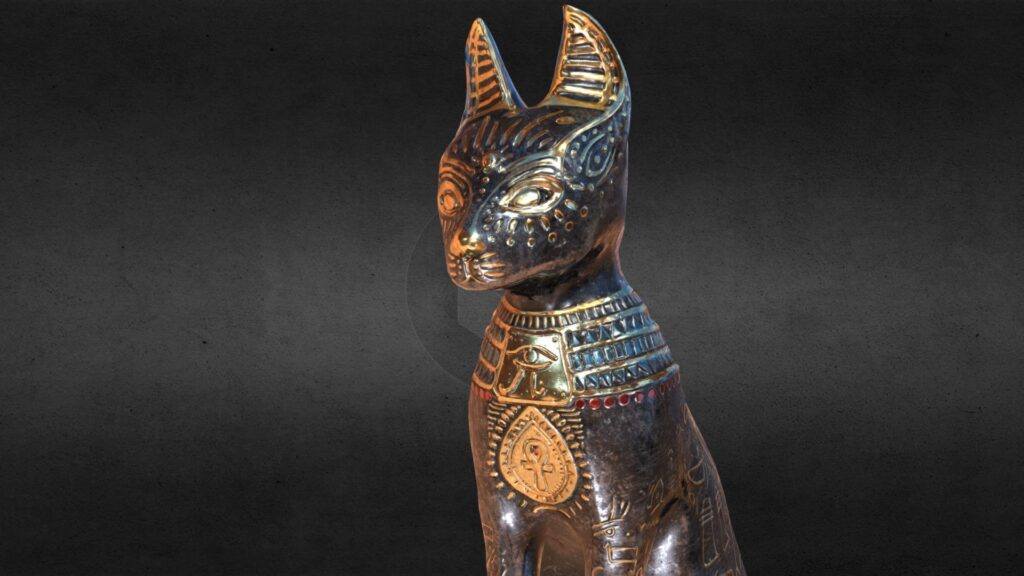
They also formed a perimeter around the flames designed to keep cats at a safe distance.
This reverence for cats had its downside. During the Battle of Pelusium (525 BCE), Cambysus II of Persia defeated Egyptian pharaoh Psametik III, conquering Egypt. Cambysus had his men round up animals, especially cats. These they drove before their invading forces toward the fortified city of Pelusium on the Nile.
Persians painted images of cats on their shields and may have carried cats in their arms as well. The Egyptian historian Polyaenus (second century CE) writes that, after the surrender, Cambyses and his army rode in triumph through the city. As they rode, they scornfully hurled cats into the faces of the defeated Egyptians.
Egypt does retain the honor of giving us the name “cat.” The word derives from the North African name, “quattah”.
CATS IN INDIA
Early writing in India includes mention of cats. They find their way into the two great literary epics of ancient India, the Mahabharata and the Ramayana. Both of these stem from circa 5th or 4th centuries BCE.
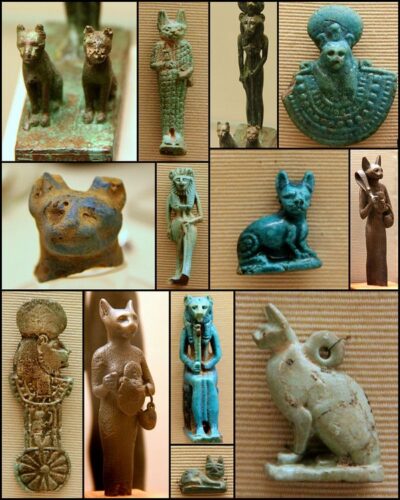
In the Mahabharata, a cat and a mouse help each other escape from death. They then discuss at length the nature of relationships, especially those in which one of the parties involved is stronger or more powerful than the other.
In the Ramayana, the god Indra disguises himself as a cat so that he might escape the husband of the beautiful maid, Ahalya. This escape becomes necessary because Indra has seduced the maiden.
The Indian regard for cats had its basis in reverence, as the cat goddess, Sastht, played much the same role in India as Bastet did in Egypt.
A PERSIAN TALE
This tale claims that the cat began as a magical creation. The Persian hero, Rustum, saved a magician from a band of thieves. As a reward, the magician performed an amazing magical trick. He took a handful of smoke and added flame. Next, he brought down two of the brightest stars in the heavens.
These he kneaded together and blew on them. When he opened his hands to Rustum, the warrior saw a small, smoke-grey kitten. Its eyes were as bright as stars and its tiny tongue that darted out appeared like the tip of a flame.
Thus, the magician created the Persian cat as a token of gratitude for the saving of his life.

MYTH FROM ANCIENT CHINA
A Chinese myth centers around the goddess Li Shou. According to this story, in the beginning of the world, the gods appointed cats to oversee the running of their new creation, and at first, gave them the power of speech.
It turns out that the cats didn’t want this overseer’s job but showed more interest in sleeping under the cherry trees and playing with the blossoms. These activities they found much more enjoyable than the mundane task of running the world.
Three times the gods checked on how well the cats were doing, and each time they found them sleeping or playing. When they visited for the third time, the cats explained to them that they had no interest in running the world. They suggested that humans should fill the position instead.
The gods agreed to this change, and revoked the cats’ power of speech and gave it to humans. However, the cats remained entrusted with the important task of keeping time, thus maintaining order.
In China you may still find the belief that one could tell the time of day by looking into a cat’s eyes.
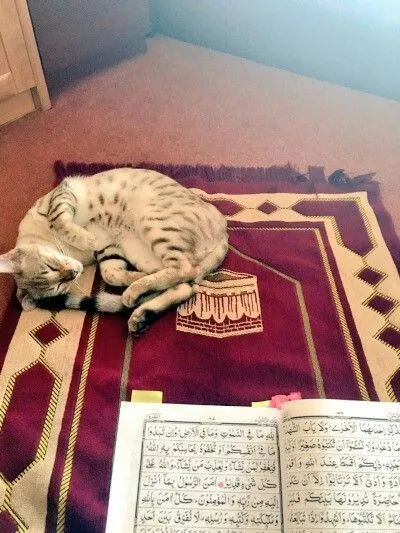
A LOOK AT ANCIENT ARABIA
You will find other stories on this website about Muhammad and his love of cats. He outlawed the harming and killing of felines. From his caring for cats come two interesting beliefs. One of them refers to the M on many cat foreheads: This supposedly first occurred because Muhammad stroked the cat’s head.
In another legend, a cat belonging to Muhammad’s ally, Abu Hurairah, saved Muhammad from a snake’s attack. In return, Muhammad petted the cat along his back and granted him the ability to always land on his feet.
CONCLUSION
These stories represent just a few about ancient cats. By examining these legends from times long past. one can see that cats have made their own place among us throughout history. Still enigmatic, they remain a challenge to our understanding. Ongoing research helps us to learn more, but the mystery still continues.
References I used for this post: worldhistory.org/article/466/cats-in-the-ancient-world smithsonianmag.com/science-nature/how-cats-conquered-world-180963749/ http://catster.com/the-scoop/the-history-of-cats-cats-in-the-ancient-world

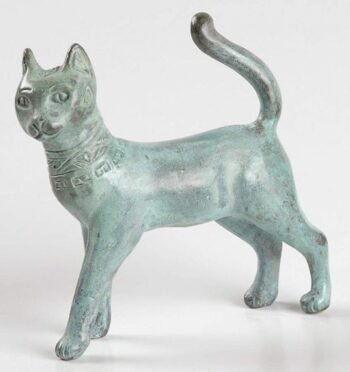
Great collection of legends and information about cats. Thanks for the research and sharing.
You are so welcome, Elaine! Each time I research, I, too, learn something new about cats. Such fascinating creatures!